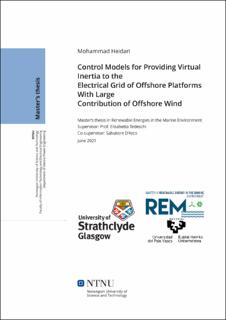| dc.description.abstract | Norway as one of the leading countries in the oil and gas and (floating) offshore
wind energy sectors, plans to reduce its carbon emission according to the
European commission strategy to become carbon-neutral by 2050. One of the
considerable contributors to the carbon emission in Norway are oil and gas platforms.
Supplying these platforms through offshore wind can accelerate realizing
carbon-neutrality.
A well-built grid can withstand a contingency event and have an acceptable
rate of change of frequency due to high inertial characteristics. The reduction of
the grid inertia is one of the main issues with the paced integration of renewable
energy sources into the electricity grid and replacing the conventional generators.
To overcome this issue, multiple mathematical methods have been developed to
ensure grid stability. These methods are based on an additional energy source to
help the system stability throughout the event of a contingency.
In this project, a few of the methods to provide virtual inertia for renewable
energy sources are reviewed and compared against each other. Based on the ideas
inspired by these methods, an algorithm is proposed to assist the inertial response
of the grid of oil and gas platforms.
The proposed algorithm is implemented on a voltage source inverter that extracts
energy from energy storage and injects it into the grid of the platform alongside
gas and wind turbines. The method is validated by a step-change in the load
of the platform and the interactions of the grid components are presented. Compared
to a scenario in which there is no inertial support provided, the proposed
method proves operational in reducing the rate of change of frequency and therefore,
stabilizing the grid during the contingency.
Key words: Electrification of oil and gas platforms, Offshore wind turbine,
Virtual inertia, vector control of converter, Back to back converter control, DFIG,
gas turbine, Energy storage | |
